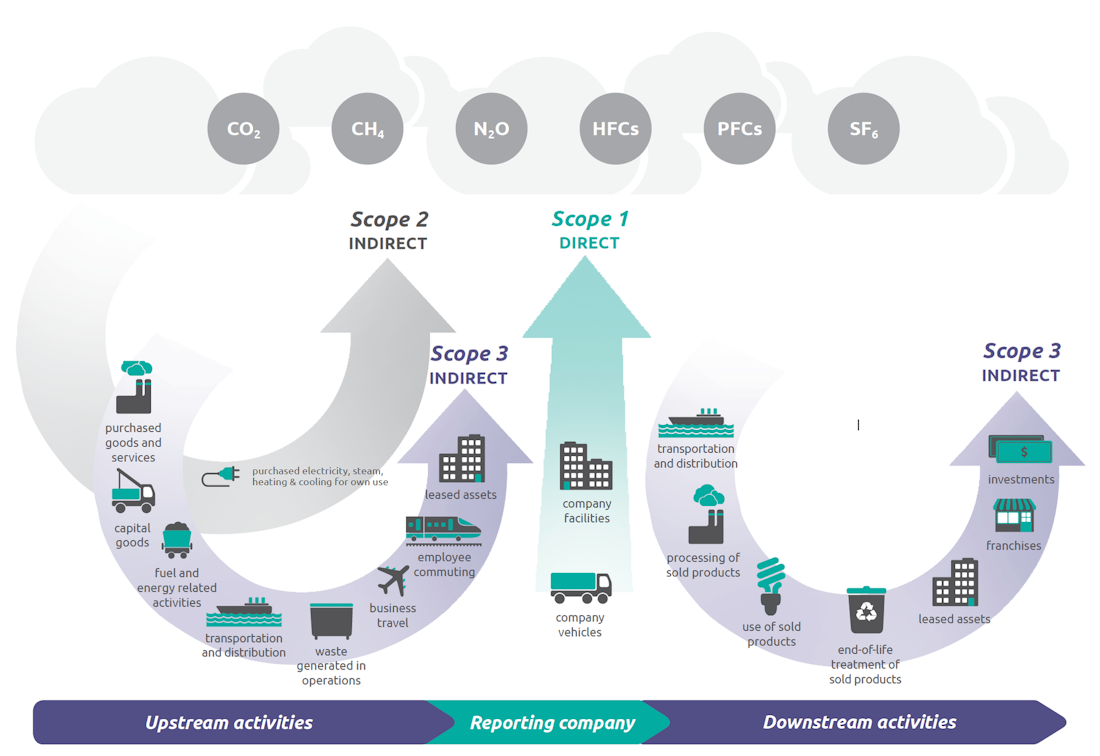Sustainability with everything, please.

Shopped sustainably today? Commuted to the office sustainably? Made a sustainable internet search? Sustainability follows us at every turn. And it's a bit annoying because the word is used for everything and the opposite - the difference between honest efforts and greenwashing is hardly recognizable anymore.
So it's all hot air? No, of course not. But what does sustainability mean for us as an SME? What impact do we have on the environment with our activities? And how can we make our contribution to a more sustainable society?
What we talk about
Before we start, let's take a few steps back. What does Sustainability exactly?
A common definition comes from the UN Brundtland Report von 1987 (translated analogously):
«Sustainability means meeting the needs of the present without compromising the ability of future generations to meet their needs.»
How can we get closer to this goal? We need a sustainability strategy!
Strategy: four steps to sustainability
We have opted for a four-step approach:
- Materiality Assessment Which sustainability topics are important to us?
- Corporate Footprint How big is the footprint of our activities?
- Sustainability Roadmap Where do we want to go and how do we get there?
- Ecodesign & Engagement How can we make our activities more sustainable and who will support us?
1 - Materiality Assessment
The first step is to be clear about your own intentions: Which areas do we want to tackle?
In the corporate context, sustainability encompasses three fields of action:
- Social affairs and society
- Economy
- Environment
In fields of action 1 and 2, we have already changed a great deal in our company in recent years without - until now - associating this with the term sustainability. This includes
- Flat hierarchies: We don't have top and bottom, we have roles.
- We have Comprehensible and transparent wages introduced.
- The Advice Process allowed all to make decisions.
- With the monthly One-on-One with the Buddy we have created a space for personal concerns.
Of course, this is not enough. But it does indicate that we already have a culture of reflecting on structures and making them suitable for everyone involved - in the spirit of New Work. Also, maximizing profits for shareholders has never been the goal of smartive:
- At least one third of the profit is distributed to the employees.
- 14 of the 21 employees are also shareholders and those who own shares work at smartive.
- Anyone who works 100% has two and a half weeks per year for further training.
- Anyone embarking on a CAS, Bachelor's or Master's degree is supported without obligation with 28 paid study days per year.
- We donate CHF 500 per employee to charitable organizations every year.
And the environment?
That leaves point 3, the environment. We would like to focus on this in our sustainability strategy.
So far, it has mainly been larger companies such as Google and Apple that have jumped on this bandwagon and have committed to net-zero CO₂ emission targets, for example - to name just one aspect.
Even if we only are a small service company, we want to do our bit for the environment. So, with the support of Christopher Zimdars (environmental engineer, ETH), we set out on our journey.
2 - Corporate Footprint
In order to obtain an overview of our consumption, we first calculate our Greenhouse gas footprint. We are limiting ourselves to the years 2019 and 2020.
How?
We have calculated all emissions caused by our activities using the Greenhouse Gas Protocol which is a globally recognized standard for the accounting of greenhouse gas emissions. This includes all emissions from air conditioning in the office to business mobility and the coffee we drink.
What does that mean exactly?
The Greenhouse Gas Protocol divides emissions into three scopes (see figure), with Scope 3 in turn divided into 15 categories.

To make the data easier to compare, we limit ourselves to one unit: CO₂-equivalent environmental impact. For each scope and category, we want to find out the following:
- Which data is important and should be reported?
- Where can we find this data?
- How do we arrive at the CO₂ emissions? (Conversion using emission factor)
- Is the result correct?
- Are we in a good or bad position?
Sounds quite simple. But unfortunately it's not, because:
It gets complicated in the details
When collecting data, we sometimes get lost in the details. What data is important? How accurate should it be? Which emission factor applies to our company? For example:
«What do 2000 km train journey?2000 km * 0.00815 kg CO₂ = 16.3 kg CO₂ = 0.0163 t CO₂»
The calculation is correct and provides a figure: 0.0163 tons of CO₂. Plausible, yes. But the supposed clarity of a figure conceals how it was arrived at:
To the category Business travel includes all emissions from the transportation of employees for business-related activities in vehicles that do not belong to the company, e.g. aircraft, trains, buses and cars. This includes business trips, customer visits and company outings.
- What belongs in it and what doesn't?
- How exactly should we identify our customer visits?
- Do employees still know which customer visits they made in 2019?
- What is the correct emission factor?
Other categories such as Use of sold products give rise to additional uncertainties: What happens to the software we sell? How much kWh does it consume during operation?
When we then summarize the first detailed data collection, the following figures emerge: in 2019 we have 77 t CO₂ eq. und im 2020 46 t CO₂ eq ejected.
What does that mean now? How are we doing? Good? Bad?
To get an overview and classification, I turn to my daily helper - Google.
«Me: Hello Google, What is the ecological footprint of other companies?Google: There you have a comparison of the top 10 companies.Me like this: Well, they compare companies with completely different measurement methods and measurement accuracies.Google: Yes, full. It's like this.Me: ...»
Okay, we're not getting anywhere like this. So let's take another step back: What is a ton of CO₂ anyway?
With one tonne of CO₂, one person can fly once from Zurich to New York (one way). The emissions from smartive in 2020 therefore correspond to 26 flights to New York and back to Zurich. Or 6 trips around the world in one plane.
We have created a dashboard to provide our customers and employees with an overview of our emissions over the years. This shows the data based on the scopes and categories of the Greenhouse Gas Protocol.
What do we take away from the Corporate Footprint?
Despite standards, every company measures its footprint differently. A comparison is difficult. In addition, much of the data is based on estimates.
In hindsight, we all agree that we wouldn't calculate the footprint that precisely again. As a small service company, the cost/benefit effect is simply too small. Many of the factors that we have identified are often only estimated or even completely omitted by larger companies.
An alternative path for SMEs
The Google search mentioned above had a good side effect: it led me to the Eco Compass advisory service. The city of Zurich offers all companies in the city of Zurich a free consultation session on sustainability in the workplace.
Thanks to our data collection for the greenhouse gas footprint, we already had all the necessary key figures (and even more).
Using our data, our consultant from myclimate showed how we compare to others. For example, he calculated our electricity consumption back to the employees and said that we are well on average, even a little better 😎.
And now?
The fact that ecological thinking is already anchored in the minds of employees is demonstrated by some of the measures that have already been taken:
- 🍽 At company events, the food is always vegetarian or vegan.
- 🌿 Our carpets are second hand.
- 🍎 The weekly fruit bowl is organic and mostly regional.
- 🍻 Our beer comes from Zurich.
- 🚄 All employees commute to work by public transport or bicycle.
3 - Sustainability Roadmap and 4 - Ecodesign & Engagement
The Corporate Footprint has once again given us a deeper understanding and insight into our consumption. But where do we want to go with it and how do we get there?
One thing is clear: we want to do our bit for the environment. We want to define the necessary measures by the end of 2021. Or hmm, maybe...
«Me: Google, how do we become sustainable?Google: Set targets!Me: OK Google.»

Written by
Céline Salzmann





